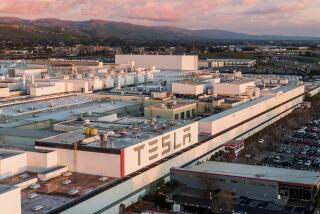High Levels of Toxin Seen at 9 Chlorine Plants
- Share via
A new report has found that nine chlorine factories are among the nation’s largest sources of mercury, a potent neurotoxin that spreads globally and has rendered some seafood unsafe to eat.
To be released today, the report, written by the environmental group Oceana, documents what it calls a “long-overlooked” source of mercury polluting the air. The findings are based on a review of toxic inventories filed by the chemical companies.
The chlorine industry and the U.S. Environmental Protection Agency acknowledge that the chemical plants have been a sizable source of mercury pollution. But they say the companies have substantially reduced their emissions in recent years.
Most U.S. efforts to control mercury have focused on coal-fired power plants, which are facing controversial and costly new efforts to regulate their emissions. But the report concludes that nine chlorine plants, mostly in the Southeast and Midwest, could be releasing as much, or more, mercury than the power companies are.
“The nine mercury-based chlorine plants in the U.S. may rival the entire power industry as the nation’s largest industrial mercury polluter,” says the report by Oceana, which is launching a campaign to reduce the levels of mercury and educate the public about its dangers.
Mercury is considered one of the most hazardous and ubiquitous contaminants. Emissions from factories and power plants travel thousands of miles in the air and drop into oceans and lakes, building up in the tissues of animals and people.
The mercury-cell chlorine factories each reported emitting an average of 1,097 pounds of mercury into the air in 2002, five times more than the average power plant, according to Oceana’s analysis of reports that companies filed annually with the EPA. Eight of the nine plants rank among the top 25 U.S. companies in reported mercury emissions, the report says.
But their actual emissions could be much higher. How much mercury they release into the environment is largely unknown, because many tons are “missing” at the chlorine plants every year -- unaccounted for in the companies’ annual inventories, according to a 2004 industry report.
Chlorine is used for manufacturing vinyl, disinfecting drinking water, producing medicines and making cleaning solvents, among other uses. Most chlorine is produced using new, mercury-free technologies, but nine factories use a process that pumps a saltwater solution through a vat of mercury to set off a chemical reaction.
In 2000, 11 chlorine plants reported releasing 14 tons of mercury into the air through smokestacks and unmonitored leaks called “fugitive” emissions. But according to the EPA, another 65 tons of mercury were used there and unaccounted for.
EPA officials, in a 2003 report, said “that the fate of all the mercury consumed” at the chlorine plants “remains somewhat of an enigma.”
If even half of that “lost” mercury were released into the air, the plants would have polluted the air with nearly the same volume as the 49 tons released by the nation’s 497 mercury-releasing power plants that year, said Oceana’s pollution campaign director, Jackie Savitz.
By 2002, two of the 11 plants had closed, and the reported mercury emissions dropped almost in half, to a total of 7.6 tons. The plants, however, had 28 tons of mercury that were unaccounted for, which amounted to about 1% of their total mercury used and stored, according to a 2004 Chlorine Institute report to the EPA. The missing mercury amounted to 30 tons in 2003.
Tracy Cullen, director of communications at the Chlorine Institute, an industry group, said the industry was trying to develop more accurate methods to measure fugitive emissions and account for all of its mercury. Although emissions from smokestacks and vents are measured with precision, fugitive emissions from the mercury vats are much more difficult to quantify.
“As an industry, we support the regulation of mercury,” Cullen said. “The chlorine industry’s use of mercury is on the way down.... We are committed to fully account for the mercury we use.”
EPA spokeswoman Cynthia Bergman said the missing mercury was “a very important issue” to the agency, which had been working with the chlorine industry to resolve it. But, she said, there was “little evidence” that it was being released into the environment.
Instead, EPA and chlorine company representatives suspect that the dense metallic chemical remains inside the plants, accumulating in their piping, tanks and processing equipment. “Several tons of mercury could easily be caught in the thousands of feet of pipe in one plant,” Bergman said.
The EPA tightened rules regulating the chlorine plants in 2003, but environmental groups criticized the agency for failing to shut them down if they didn’t switch to mercury-free technologies.
Since the mid-1990s, the volumes of mercury used by the chlorine industry declined 76% because five plants closed and others upgraded, according to the Chlorine Institute.
The chlorine companies say they will further reduce mercury emissions by as much as 93% under the new EPA regulation.
“There is no good reason to eliminate more U.S. manufacturing jobs by closing plants that are operating safely and performing above and beyond all federal and local standards,” Cullen said.
The nine plants are located in Louisiana, Alabama, Delaware, Georgia, Ohio, Tennessee, West Virginia and Wisconsin, and are operated by Olin Corp., Occidental Chemicals, PPG Industries, Ashta Chemicals Inc., Vulcan Chemicals and Pioneer Companies Inc.
The United States is responsible for a small fraction of mercury emissions worldwide. Globally, about 1,500 tons per year are released by coal-fired power plants and waste incinerators, about half in Asia, according to a report by the United Nations Environment Program. Europe has 53 mercury-cell chlorine plants.
One in every six babies in the U.S. -- more than 600,000 per year -- is born to a mother with a mercury level exceeding that deemed safe for a fetus. Mercury is known to interfere with brain development.
The Food and Drug Administration has advised women who are pregnant, nursing or may become pregnant to avoid eating large marine predators such as swordfish, shark, tilefish and king mackerel, and to eat no more than 12 ounces of other fish per week.
*
(BEGIN TEXT OF INFOBOX)
Mercury mess
There are nine mercury-cell chlorine plants operating in the U.S., mostly in the Southeast and Midwest. Together they emitted more than 7 tons of mercury in 2002. The total emissions comprise air, water and other figures.
Emissions (in pounds)
*--* Rank City Total 1 Charleston, Tenn. 2,512 2 New Castle, Del. 2,238 3 New Martinsville, W.Va. 2,167 4 Muscle Shoals, Ala. 1,771 5 Ashtabula, Ohio 1,568 6 Port Edwards, Wis. 1,462 7 Lake Charles, La. 1,460 8 St. Gabriel, La. 1,184 9 Augusta, Ga. 1,028
*--*
*
Source: Oceana
More to Read
Sign up for Essential California
The most important California stories and recommendations in your inbox every morning.
You may occasionally receive promotional content from the Los Angeles Times.










